
In 1910, the sociologist Gustave Le Bon wrote the introduction to the French edition of Lombroso’s last finished work, published posthumously in 1909, of researches into hypnotic and spiritualistic phenomena,1 presenting a mass of facts, figures and first-hand accounts of a sort typical of the positivistic approach, in favour of ghosts, luminous materialisations and ectoplasms of which Lombroso himself had been a spectator in the course of innumerable spiritualistic séances. Le Bon’s lapidary comment on what appeared as Lombroso’s slide into irrationality was that, ‘from the moment that he began to study spiritualistic phenomena, his science deserted him and was replaced by endless credulity’.2
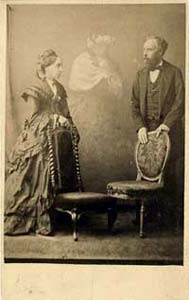 |
| F. Hudson, Mr. and Mrs. Shorter, Georgiana Houghton, medium, 1873 |
In point of fact, Lombroso’s interest in spiritualism dates to many years earlier and appears to have taken on the form of a genuine turn in his epistemological orientation. In the Studies on Hypnotism of 1886, while registering among the symptoms of hysteria and of neuropathology such phenomena as the thought transference and magnetisation, he took a firm position against any belief in what he called ‘spirits in looking-glasses and in arm-chairs’, emphasising the atavistic nature of such magical superstitions: ‘beware that, with such thing, we end up back with the Totem or the Fetish’.3 Two years later, the Neapolitan spiritualist Enrico Chiaia invited Lombroso in the columns of the national press to be present at a spiritualistic séance, which took place in Naples in 1891. Thus began Lombroso’s association with the medium Eusapia Palladino, leading not only to the many séances in which they both took part – seventeen in 1892 alone in Milan – but also to the replacement to which Le Bon was to refer, namely the passage from the field of science to that of the occult, from positive fact to magical fact.
Rather than refer to a replacement, and so to the idea of Lombroso as in flight from positivism, it is perhaps preferable to think of a ‘twist’ within that very positivistic knowledge of which Lombroso had made himself the spokesman and promoter. Rather than think of the scientist sliding towards the fantastic dimension of the spectral, we might configure the emergence of an imaginary that was already inscribed in the very project of the positive sciences, an imaginary that Lombroso carries to its extreme consequences investing it with the shape and form of a phantasmatic revelation.
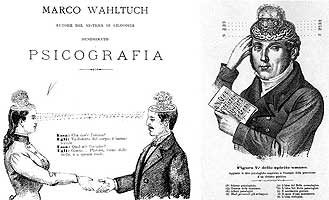 |
| Illustrations from M. Wahltuch, Psicografia, 1870 |
In any case, Lombroso’s operation can be placed within a fin de siècle movement in science and medicine that is already impregnated with the same double register. Since 1882 in England the Society of Psychical Research (of which Lombroso became a member) set itself to collect and classify with all positive rigour spiritualistic manifestations that included telepathic communication between living brains, which thus inevitably reconfigured them as spectral places inhabited by the ghost of the other.
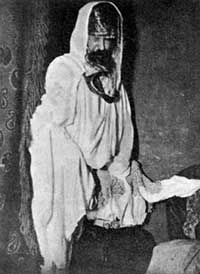 |
| C. Richet (attributed to), Materialization of the ghost of Bien Boa, from C. Lombroso, Ricerche sui fenomeni ipnotici e spiritici, Turin, 1909 |
This is the moment in which is born what we might call a first great ghost archive, namely the enormous compendium Phantasms of the Living (1886), made up of more than seven hundred witnesses of ‘living ghosts’ and edited by Edmund Gurney, Frederic Myers and Frank Podmore. In his turn, Lombroso would call on this in his Researches, referring to its foundational role in the elaboration of another archive of spectral traces, namely that of the dead: ‘if the ghosts of the living make those of the dead superfluous, they also make them possible’.4
Likewise in Germany, with the psychological researches of Schrenck-Nötzing,5 and in France, the phenomena of hypnosis and telepathy came to be explained in terms strongly tinged with the phantasmal; and especially in medicine the double register was invoked in seeing hysteria as a condition that turns positive fact into magical fact and vice versa. Charcot for instance regarded the hysterical body as the realisation of the Cartesian model of the human machine, which can turn itself into a medium able to produce and manifest ectoplasms.
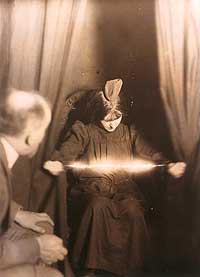 |
| A. von Schrenck-Nötzing, The medium Eva C. with a materialization on her head and a luminous apparition between her hands, 17 May 1912 |
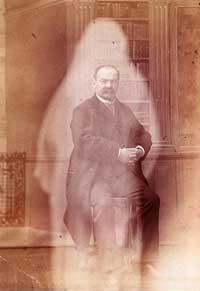 |
| P. Nadar, Portrait of Albert de Rochas and his astral body, Paris 1896 |
In the 1880s, the physician Antoine Baréty performed experiments to show that the bodies of hysterics were lit up by the spasmodic consumption of energy and gave off an astonishing ‘radiating neural force’, a luminous fluid that flooded out particularly from the eyes, the fingers and the mouth, swathing the body in an aura of light.6 What already in the 1840s Karl von Reichenbach had dubbed the ‘odic force’ cam to be known as the hysterical aura, as we can see in two striking cases of the ‘twist’ between pathology and the occult. The first concerns Charles Richet, Professor of Physiology in the Medicine Faculty in Paris and member of the SPR, who passed from enquiries into the hypnosis of hysterics to mediumistic experiments and ended up coining the word ‘ectoplasm’. Perhaps less well-known today, though more intriguing in its upshot, is the case of Albert Rochas, an engineer who was administrator in the élite École Polytechnique, who studied the ghost of sensibility in hysterics, conceiving of the luminous energy given off by their bodies as a sort of extroflected inner double, as the garment of the senses that abandons the flesh and takes on the spectrality. In describing the phenomenon of the ectoplasms, Lombroso himself cites Rochas’ study of the processes described in Extériorisation de la sensibilité (1895), reading the phantasm as precisely a garment that duplicates and exteriorises the bodily inside:
the patient’s sensibility is carried, like the clothes on a mannequin, on a sort of phantasm that, under the orders of the magnetiser, can move off on its own and pass through material obstacles while preserving its sensibility intact.7
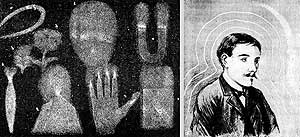 |
left: Drawing from A. de Rochas, Le Fluide des magnétisateurs, 1891 |
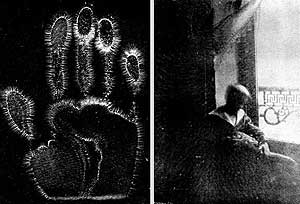 |
left: H. Baraduc, L’Âme humaine, ses mouvements, ses lumières et l’iconographie de l’invisible, 1896 |
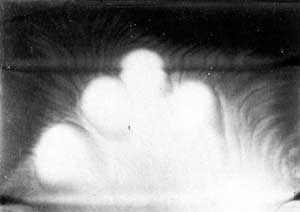 |
| J.-B. Luys, Effluvia from a hand, 1897 |
These are just two cases that serve nevertheless to indicate a whole climate that was thoroughly welcoming to the marvellous and that, as is already well known, embraced Charcot and the hospital of La Salpêtrière,8 where Mesmer’s theory of invisible fluids had long since been rehabilitated, thus encouraging, on the one hand, the interplay of medicine and stage magnetisation in which Lombroso and the popular mesmeriser Donato were involved and, on the other, a whole string of enquiries into the iconography of the luminous effluvia, among which we may mention Hyppolite Baraduc’s L’Âme Humaine, ses mouvements, ses lumières, et l’iconographie de l’invisible fluidique (1896) or those of Charcot’s pupil, the neurologist Jules-Bernard Luys. In both cases, the effort is directed at providing unmistakable photographic ‘proof’ of auras which is then called on also to show its potentially occult origin.9
It is obvious that Lombroso’s association with this environment was sure to have a startling effect, given that his standing and authority seemed to lend respectability to the culture of spectrality. Already in 1888, news of his interest in spiritualism caused controversy in all parts of the world. An article that he published in 1906 on spiritualistic phenomena soon gave rise in Italy to a unprecedented wave of interest in mediumism, documented in the articles written by the journalist Luigi Barzini, who was sent by the Corriere della Sera to take part in Lombroso’s séances with Eusapia Palladino and to describe them for a wide public.10
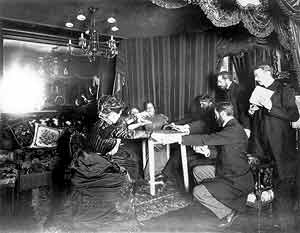 |
| H. Mairet, Séance with Eusapia Palladino at the home of Camille Flammarion, France, 25 November 1898 |
Because of their accreditation by Lombroso, the spiritualist emanations produced by Palladino focused the fascinated attention also of the scientific world and, between 1891, the year of Lombroso’s first séance with her, and 1898, the ‘evidence’ they provided was witnessed in a long run of sessions in Paris, Cambridge, Rome, Munich, Warsaw and elsewhere, involving, among others, Myers and Oliver Lodge of the SPR, Richet and Albert de Rochas, the physician Shrenck-Nötzing and astronomers such as Camille Flammarion.
A first point that can be made about these late nineteenth-century séances, and that illustrates clearly what is involved in the paradigm reversibility within positivistic science, is that the space in which the spiritualist session took place had in fact become more like an experimental laboratory, with its radiometers, electroscopes, dynamometers and photographic plates. Following Lombroso, the physiologist Filippo Bottazzi subjected Palladino to eight sessions in 1909, insisting on the primary function of ‘mechanical self-recording’ in documenting the phenomena,11 to such an extent that, in the illustrations to his 1909 book on mediumistic phenomena, it is the technology that takes the limelight, stealing the show from the iconography of the apparitions themselves. Lombroso too stresses the positivistic and systematic nature of the mediumistic experiment, gathering figures, measures and mechanical traces of the physiopathology of Eusapia Palladino in the trance state.12
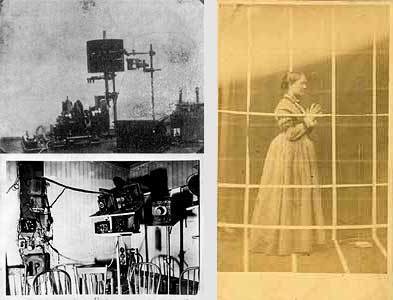 |
| left: Recording equipment used in séances. right: Spirit photograph. |
The experimental methods of science are thus continually affirmed and centre precisely on the rhetoric of the visible trace as the revelatory clue on which depends much of the positivistic investigative paradigm.13 Just as Lombroso’s physiognomic bodies, measured and decomposed in the finest detail, provide access to what is invisible in matter, so the mediumistic traces show how its dark inside is manifest on the outside, written on the skin.
Lombroso himself tells us that hypnotised bodies, thrust into a trance like that of the medium ‘offer us something like an autopsy of the various faculties of the soul’:14 the medium’s body thus gives access to death (the autopsy), but from the point of view of life: it is a body that can ‘play dead’ only because it is alive. Death thus makes itself visible in life through the medium, in her vital signs, which in turn means that that body already shows the structure of the spectral: death returns as life, as a set of traces that I can record, measure, catalogue and that, by giving form to the phenomenon, allow me to possess it. The scientist thus discovers the logic of phantasmatic revelation in the very body of the medium and in the mechanical traces that make its ‘spectres’ appear as a physiognomy of the invisible, even before there come on the scene any ectoplasms or apparitions. From this standpoint, the spiritualist enquiry does not come to bury positivism, but to fulfil its highest ambition, that of making death visible, narratable as a ‘vital’ process within matter itself. It is not by chance that Lombroso concludes his Researches on Hypnotic and Spiritualist Phenomena discussing a ‘biology of spirits’, of which he gives an outline and which he sees as the ultimate challenge of the positivistic method.15
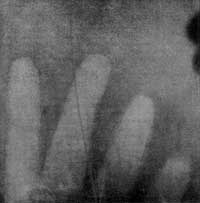 |
| Imprint left by a ghost hand on a photographic plate, from C. Lombroso Ricerche sui fenomeni ipnotici e spiritici, 1909 |
Once this premise is granted, the structure of the séance can be seen as peculiarly doubled en abîme. The fin-de-siècle scientist demands visible traces, positive facts, and the generic mediumistic revelations that satisfied in the 1850s will no longer do: the medium must produce a full iconographic repertoire of spectres. The vague luminescences and the fuzzy phantom limbs typical of the earlier séances are thus dizzyingly amplified: Lombroso reviews materialisations of bodies, neoplastic appendices, marks of hands and faces, photographic prints, busts, pictures, portraits, gifts, lithographic writings and so on. Commenting on them, he repeatedly insists on the materiality of these images, on the fact that they create the body of the departed physically. For instance, the materialisations are described as ‘creations ex novo, […] more or less organised forms, with the physical characteristics that we attribute to matter’; the phantom limbs ‘are usually hands, arms, shoulders and also heads that […] seem parts of a creature that is in the process of being formed’; the spectral hands have ‘features of parts of a living creature. One can feel the skin, the warmth […] and, if grasped, they give the impression of hands that are dissolving, that are fugitive, as if they were made of semifluid substances’.16
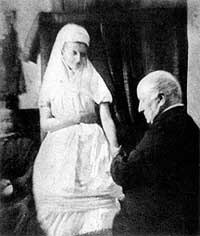 |
| W. Crookes, The surgeon Dr. James M. Gully recording the pulse of Katie King, 1874 |
In other words, the forms of the occult revelation must mirror those of the positivistic revelation, and the medium is required to share the scientist’s passion for traces. This very mirroring relation was what rendered the space of the séance so potent an object of imaginative investment, in which the magic fact undergoes exponential growth relative to the passionate drive to uncover positive facts, and the medium becomes the scientist’s double in that she unfurls (or, here too, reveals) the fantastic underside of his project, while holding out the possibility of a double belief (both in the fact and in the occult). It was this that gave the underlying meaning to the operation set on foot in the 1870s by the scientist William Crookes, who was the first to have redirected the protocols of the mediumistic session towards those of the experimental test, in which the empirical collection of the visible signs and numbers took the place of the evocative rite.17
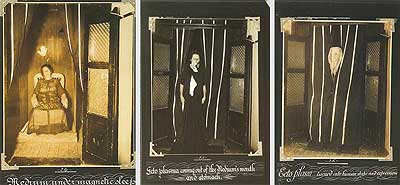 |
| F. Ponte, Medium under magnetic sleep inside the cabinet; Ecto plasma coming out of the Medium’s mouth and stomach; Ecto plasm turned into human shape and expression, 1912-23 |
It is no accident that it was the body of a medium observed by Crookes that produced one of the first phenomena of so-called ‘complete materialisation’, which is to say the apparition of a phantasmatic anatomy as a whole, the photographic image of which was presented as unmistakable proof – or indeed as its equivalent, given that the process of materialisation seemed to mimic that of photography: Crookes’ medium withdrew into a darkened room (camera obscura) and there produced a double of herself that emerged into the light. ‘The medium herself became a sort of camera, her spiritual negativity bodying forth a positive image, as the human body behaves like an uncanny photomat, dispensing images from its orifices’.18
As we are beginning to see, the medium’s body is the other item that must be considered if we are to understand how much is at stake in the positivistic appeal to ghosts; and here too we can set to one side its spiritualistic manifestations, even though it makes them in a certain sense unavoidable. For, we find in this body the epitome of an overall vision of matter as a vast system of radiating energy regulated by the principle of electromagnetism and based on the paradigm of the ether as the conductor of light and sound waves. It is the image of an enormous networked organism, pervaded through and through with nervous wiring through which sensory impressions are carried to the nerves of the human machine that in turn vibrate thus creating thought: as Lombroso wrote in his New Studies on Genius:
we are like an electric wire that transmits a signal, but that is not aware of what the signal means, nor what it adds up to in combination with other signs. We transmit a sensation to the brain and this is elaborated and transformed into thought. Man, in short, is a sort of medium for the brain.19
This theoretical background, shared by physiology, physics and chemistry, allows contact and action at a distance to be thought of as phenomena intrinsic to matter, rather than as occult events. In The Unseen Universe (1875), the physicists Balfour Stewart and P.G. Tait interpreted the ether as ‘a way in which the universe conserves a memory of the past’: every event, every experience and every sensation endures as if recorded, impressed on the light waves of matter, because, as they say, ‘photographs are continually produced and conserved of every event’.20 In 1884, the mathematician Charles Howard Hinton takes up this image of the conservation of energy in his A Picture of our Universe, this time comparing the ether to a cosmic phonograph, which serves as an interface between the third and the fourth dimension.21 The ether is thus the enormous archive of invisible traces, a crypt in which the sensible imprints of the past are preserved like ghosts ready to show themselves anew, intimate but distant: telepathy is just this, a tele-pathos, an intimacy that is reproduced at a distance in time and space through the mere contact of energy waves, as Frederic Myers (the inventor of the term) confirms in placing spectral communication firmly among the scientific ‘laws’ of nature:
today science is able to penetrate certain cosmic facts that it hitherto had not grasped. The first of these is man’s survival of death. The second is the registration in the universe of every scene and thought of the past.22
What, then, is the role of the medium’s body in this context? On the one hand, its tendency towards the hypnotic trance places it among the forms most dangerously close to matter: the pure working of the nervous machine is a clear sign of atavism, of a regression to the primitive states of the matter whose memory remains impressed on the nervous system. As Lombroso put it in the Researches:
in trance phenomena, automatism reigns supreme […] the mediumistic trance is a true equivalent of hysteria, just as, in my view, the afflatus of genius is an equivalent of the psychic bout of epilepsy, against a neurotic and pathological background.23
As Lombroso had claimed in the Studies on Hypnotism of 1886, there is no need, in explaining telepathy, to appeal to ‘supersensible intervals’; rather it is by ‘coming down to the level of animals’ that we can encounter these sorts of insect-machines that are mere recording instruments without thought or consciousness.24
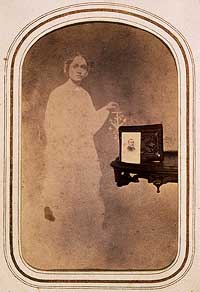 |
| Woman's spirit behind table with photograph, 1865 circa |
On the other hand, this primitive regression is what allows the medium’s body to produce an extraordinary spectral technology: precisely because it is reduced to a sensitive plate, the telepathic body becomes a photographic apparatus in which the whole of matter’s past, everything that is dead but continues to survive invisibly in the ether, comes back in the form of images. Lombroso went so far as to seek for confirmation of the bodiliness that ties primitivism to technology in ethnographic reports of the time; and he found what he was looking for in the writings of the anthropologist Mary Kingsley, whom he quotes in the Researches:
probably the more sensitive nervous system shows to them [the primitives] things that we, in our obtuseness, do not see. Theirs is a more perfect photographic plate, on which it is easier for the world beyond the grave to make an impression.25
Thus, the phenomenon of the spiritualistic séance does not amount merely to an evocation of ghosts (from beyond the grave), but to the wholly positivistic craving for a sort of panopticon of dead things, a total vision of their traces and imprints, not so that they should return – as in the case of the collector or archivist – as inert experiences to be revitalised; rather, the séance aims to give them the ‘vitality’ of the ghost and the immediacy of its paradoxical time which is at once past (distant) and present (intimate).
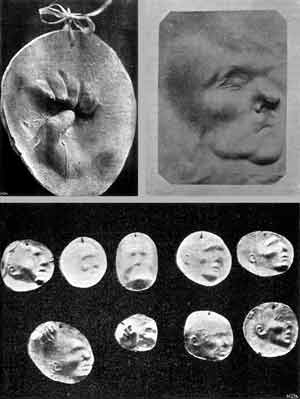 |
| Imprints of ghost hands and faces produced by Eusapia Palladino, from Bozzano, Ipotesi spiritica, 1903, in C. Lombroso Ricerche..., 1909 |
The photographic medium answers exactly to this drive, of which the fullest realisation is the photomatic human body at the moment in which the séance seems to gather into itself the whole history of the technological process of capturing, storing and finally resurrecting the past traces. With Palladino, we start with the predecessor of photography, namely the mould, which is itself a positivistic passion for legible imprints of the body, as well as, far back in the tradition, the death mask. Thus we have the extraordinary phenomenon, which Lombroso documents with his pictures, of the impresses of hands and faces made by ghosts; these were the same hands and faces that, in their search for unmistakable signs of identity, scientists had been scrutinising (we may think of Galton as well as Lombroso himself). They are, as Lombroso explained, ‘bas-reliefs’ that Palladino produced in her trance state by merely putting her hand on a sealed box containing clay or putty: the medium would say ‘it’s done’ and, in Lombroso’s words:
the box was opened and the impress was found sculpted of the hand or of the face of a being whose physiognomic expression wavered between life and death.26
A sculptor was then commissioned to ‘sculpt the reliefs from the impresses’ thus obtaining a perfect transfer of matter from the invisible (the concave, negative) to the visible (the convex, positive).
The impresses captured by the medium were then transferred onto a photographic plate, or manifested themselves as photographs, as flat, two-dimensional images. At the time, it was no uncommon to believe that the spirits had to ‘consult’ photographs to find a model for duplicating themselves, which gave implicit support to the power of photography to confer recognisable identity.27
The sculpted and photographic imprints of bodies were nevertheless just inanimate signs, though the former were three-dimensional and the latter were vividly realistic. The next stage of the revelation was thus a sort of passage, this time mobile, of matter from the invisible to the visible and from the temporal dimension to the spatial. As the writer Luigi Capuana put it, this transforms the séance into a projecting screen or ‘cinematograph superior to one invented by the Lumière brothers’.28 This is the process that Lombroso called ‘living moulage’, and that he described in the following terms: the mediumistic cabinet appears empty and the curtain that covers it is
inflated and empty: what, on one side looks like the relief of a human body that is moving the curtain by which it is covered, on the other side is a cavity in the material, a moulage.29
What we have here is a form produced and inflated out of emptiness, or a body that is pure imprint on the ether, a pure aura or web of luminous air, captured in the moment when it turns into a visible trace. The metamorphosis into a trace requires also that space becomes time and Lombroso himself observed that the space of the séance seems to take on ‘four or more dimensions’, and that ‘in this new space, the laws that govern time are reversed’.30 Adopting the living moulage as the structural principle of this reversal, Lombroso seemed to be hinting at something more, namely that the elsewhere is not another dimension, but, like the border that separates the outside of the curtain from the inside (the convex from the concave), it is nothing other than a fold, the reversible structure of a single one-sided continuous surface. Genuine ectoplasms, or the mobile and luminous auras that were projected by the medium’s body were thus the epitome of this reversibility of matter.
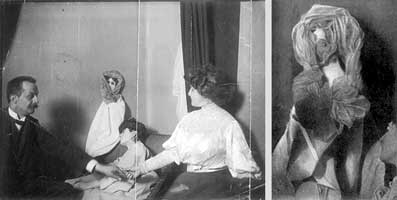 |
left: Spirit séance, photograph from Dr. Imoda’s album, in C. Lombroso, Ricerche... 1909 |
Calling on Rochas’ studies, Lombroso defined the phantasm (‘fantasima’ – his idiosyncratic spelling of the Italian word for ghost) as the medium’s ‘exteriorisation of sensibility’, a ‘sensible breath’31 that presents itself within the medium as a sensation of being ‘covered with cobwebs’:32 it is the web of the nerves, which are fully charged with imprints of the past and so with memory traces, manifesting themselves as an aura or external double. When it invades space, this interiority acquires exteriority, a skin: Lombroso frequently compared the body of the ether to a fabric that is twisted into folds: ‘the phantasms come dressed in a very fine white weave, sometimes in two, three or four layers’.33
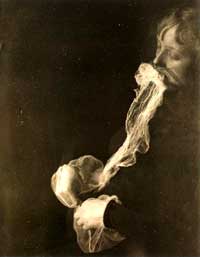 |
A. von Schrenck-Nötzing, The medium Stanislawa P: emission and resorption of an ectoplasmic substance through the mouth, 23 June 1913 |
The dominant element was thus precisely the structure of the fold, which unites inside and out, here and elsewhere, past and present, death and life. The swirls of the ectoplasm thus seemed to fulfil the positivistic dream of a total imprint, a living moulage of the body of the universe which, thanks to the mediumistic technology, is presented not as an image, as in photography or with cinematic properties, but rather recreates itself as a sensible double offering an experience that is not merely visual but multisensory. The space of the séance is much more than the white screen of the cinema, which presupposes a distance between the spectator and the anatomical scene, because that space is already the anatomy of that body, which the spectator can thus explore from within, touching, feeling, and hearing all the experiences that the mediumistic session recreates with its tactile, olfactive and sound effects.
This positivistic phantasm of total possession is obviously also a sign of the ultimate overthrow of an imaginative paradigm, the highpoint of that twist that after all makes up its greatest legacy to turn-of-the-century artistic experimentation. The phenomena of ‘mediumistic’ creation dominate the avant-garde projects from Breton’s surrealism to the spiritualistic outings of writers such as Henry James, T.S. Eliot, H.D., Vita Sackville-West, Gertrude Stein and Conan Doyle; here too we find a strong element of the modern spectralisation of the author, as we can see in the case of Conrad who, in The Life Beyond (1921), commented adversely on the evocations of Eusapia Palladino, but then could not resist describing the writer’s function in terms of the auratic phantasm:
a figure behind a veil, a presence more suspected than really visible, a movement and a voice behind the fabric of fiction.34
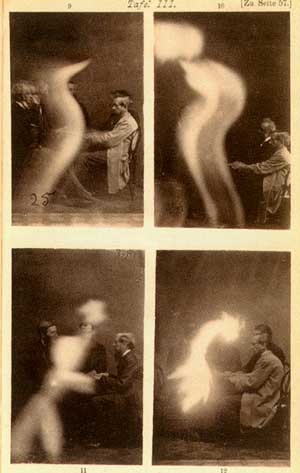 |
| J. Beattie, Spirit Photographs, 1872-73 |
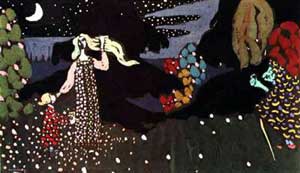 |
| W. Kandinsky, Night, 1907 |
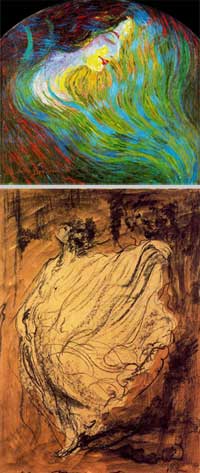 |
above: U. Boccioni, Study for a Woman’s Head, 1910 |
Or again, we find traces of it in the so-called ‘spiritualism in art’, where, for instance in Kandinsky, Lombroso’s experiences with Palladino are quoted as an outstanding example of a new horizon for knowledge within science itself;35 or in the Futurist idea of a human machine ready to generate from within itself new ectoplasmic limbs, as celebrated by Marinetti in his 1910 tract on Man Multiplied and the Machine World (‘Man will soon externalise his will and make it into a huge invisible arm […] You can easily understand these seemingly paradoxical hypotheses by studying the phenomena of he externalised will that continually reveal themselves at spiritualist séances’) and visualised by Balla and Boccioni, for whom ‘the biological mystery of mediumistic materialisation is a certainty’ (Futurist Painting and Sculpture, 1914).
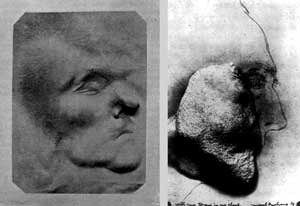 |
Imprint of a ghost face produced by Eusapia Palladino, from Bozzano, Ipotesi spiritica, 1903, in C. Lombroso Ricerche..., 1909 |
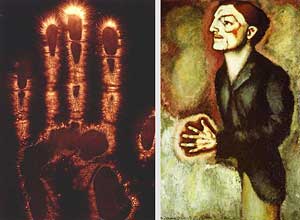 |
left: H. Schnauss, Effluvia from an electrified hand resting on a photographic plate, 1900 |
There is, however, an even more surprising affinity between, on the one hand, the mediumistic imprints produced by Eusapia Palladino, images of which began to circulate in Europe even before Lombroso’s writings, and, on the other, Duchamp’s moulds, particularly the self-portrait With my Tongue in My Cheek. As Jean Clair has documented in his book on Marcel Duchamp and the end of art, the idea that creation must be thought of as a sort of living moulage, as a operation of imprints that capture the passage of matter, its inside-outside from the invisible to the visible, in the folds of space and time, arose out of Dumchamp’s interest in auratic exteriorisations, beginning in the 1910s around the experiments of Rochas or around La Salpêtrière.36 The ghostly body or aura is the imaginary object at the centre of this operation, shared by much artistic experimentation of the day.
Also around 1910 and following explicitly on the heels of Lombroso’s spiritualistic researches, the Italian photographer Anton Giulio Bragaglia began to work on ‘infra-visible’ manifestations, publishing his iconography of it in an article with the resonant title of ‘The Ghosts of the Living and of the Dead’ (1913), in which the ‘ghosts’ had become a matter of purely auratic traces.
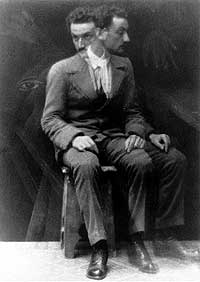 |
G. Bonaventura, Photodynamic portrait of Anton Giulio Bragaglia, 1912-13 |
Bragaglia himself described his project as aiming at capturing the image of ‘a man who gets up from a chair, leaving it empty while it still contains the man who was sitting there’.37
With Duchamp the aura became the name of an exact category, that of the ‘inframince’ (literally, the ‘below-the-thin’), to which he returned on various occasions and of which he gave the following definition, among others: the inframince is this threshold that allows one to pass from one dimension to another and is like the ‘difference between the void of a mould and the full of the corresponding moulage’; or again, it is like ‘the noise or sound that corduroy trousers make in moving’.38 As we have seen, Lombroso too appealed to this paradigm of the moulage and of auratic fabric to explain the passages of matter, and seemed to be moving in just this direction when he spoke of ghosts as ‘bodies in which matter has become so thin that it can be weighed or seen only in special circumstances’:39 the body of the medium for Lombroso and of the art object for Duchamp thus illustrate similar functions as ‘reversibility operators’, as technologies for that loss or spectral release of the aura that, using exactly the same hysterico-mediumistic vocabulary and in those very same years, Walter Benjamin individuated as the symptom of the artwork in modernity.
The model of auratic technology did not affect only the visual arts, however. So much so that a writer like Rilke could carry this enquiry into the ghosts of matter to its extreme consequences in a short text that can be read as the ultimate conclusion of the ambiguous project set on foot by Lombroso.
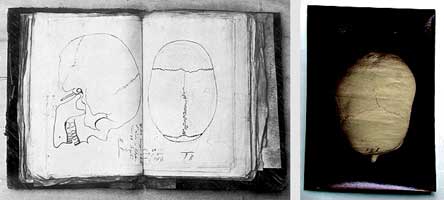 |
left: C. Lombroso (attributed to) Drawings of skulls, in Giorgio Colombo, La scienza infelice, Turin, 2000 |
In a note dated 1919 and entitled Ur-Geräusch (The Original Sound or Sound of the Origins), Rilke showed that there was no need either of a medium or of a séance to bring forth the spectral traces written on the body of matter: all that is called for is a skull, to which he imagined applying the technology that made a phonograph work, making the stylus follow the narrow path of the cranial suture. ‘Of necessity, a sound would be produced by it, a series of sounds, music’.40 If, as Lombroso claimed, the whole body is nothing but a medium for the brain, it is enough to have its mould, namely the skull, to be able to replay all the traces deposited in it and to bring back ghosts from the dead in the aural aura. The same ‘physio-technological’ procedure, as Rilke would have it, can be applied to the whole body of the world:
what variety of lines, wherever they may be found, could not be placed under the stylus and heard? Is there any contour of a sensory modality that could not be […] completed in this way so that it could be experienced, as it presents itself to hearing, transformed into another sensory modality?41
As for Duchamp, so for Rilke, creation has to begin here, from the anatomy of the invisible to which, without imagining such an upshot, Lombroso lent all the madness of his positivistic learning.
NOTES
1 C. Lombroso, Ricerche sui fenomeni ipnotici e spiritici, Unione Tipografico-Editrice, Torinese, Turin, 1909.
2 G. Le Bon ‘Introduction’ to C. Lombroso, Hypnotisme et spiritisme, Flammarion, Paris, 1910, p. 3.
3 C. Lombroso, Studi sull’ipnotismo. Con appendice sullo spiritismo, Bocca, Turin, 1886, p. 67.
4 Lombroso, Ricerche, cit., p. 312.
5 On Schrenk-Nötzing, see A. Fischer in the catalogue of the exhibition, Le Troisième Oeil. Photographie et Occultisme, Gallimard, Paris, 2004, pp. 177-83.
6 A. Baréty, Le magnétisme animal étudié sous le nom de force neurique rayonnante e circulante, Octave Duin, Paris, 1887.
7 Lombroso, Ricerche, cit., p. 234.
8 A. Harrington, ‘Hysteria, Hypnosis and the Lure of the Invisible: The Rise of Neo-Mesmerism in Fin-de-Siècle French Psychiatry’ in W.F. Bynum, R. Porter, M. Sheperd (eds), The Anatomy of Madness, Routledge, London, 1988, pp. 226-46.
9 C. Chéroux, ‘Ein Alphabet unsichtbarer’ in Im Reich der Phantome, Cantz, Ostfildern-Ruit, 1977, pp. 11-22, and ‘Le photographie des fluides: un alphabet des rayons invisibles’ in Troisième Oeil, cit. pp. 114-46. Cheroux rightly points out the influence of Röntgen’s 1886 discovery of x-rays in legitimating the idea of radiating material and of an iconography of the invisible; thus, the fluids would be reverse of radiography insofar as it is the body itself that is the cource of the radiation, rather than as the ‘negative’ that is pentrated by the invisible light.
10 The outcome of these excursions into the world of séances was L. Barzini, Nel mondo dei misteri con Eusapia Palladino, Baldini, Castoldi & Co., Milan, 1907; Lombroso’s ‘Sui fenomeni spiritici e la loro interpretazione’ forms the book’s preface.
11 F. Bottazzi, Fenomeni medianici osservati in una serie di sedute fatte con Eusapia Palladino, Francesco Perrella Editore, Naples, 1909, p. 30.
12 Lombroso, Ricerche, cit., the whole of ch. III is devoted to ‘the physiopathology of Eusapia’ (pp. 78-84).
13 C. Ginzburg, “Clues: Morelli, Freud and Sherlock Holmes”, in Thomas Sebok (ed), The Sign of Three: Dupin, Holmes, Pierce, Indiana University Press, Bloomington, 1983.
14 Lombroso, Studi, cit., p. 34.
15 Lombroso, Ricerche, cit., ch. XIV, entitled ‘Epilogue. Outline of a Spirit Biology’ (pp. 201-304).
16 Lombroso, Ricerche, cit., p. 74.
17 On Crookes’ key role in modifying the mediumistic rite, se R. Noakes, ‘Instruments to Lay Hold of Spirits: Technologizing the Bodies of Victorian Spiritualism’ in I. Rhys Morus (ed), Bodies/Machines, Berg, Oxford, 2002, pp. 125-63.
18 See T. Gunning, ‘Phantom images and Modern Manifestations’ in P. Petro (ed) Fugitive Images: From Photography to Video, Indiana University Press, Bloomington, 1995, pp. 42-7, p. 58. The case of Crookes and the photograph of the ghost of Katie King are taken up by Lombroso in the Ricerche as a first certification of the truth of the phenomena of materialisation, see op. cit., pp. 190-2. Given Crookes’ fame and impeccable reputation as an active member of the Royal Society, his experiments may be said to mark the beginning of a new ‘positivistic’ phase of mediumship, where, in line with Crookes’ own preference, the photographic evidence plays a decisive role. He himself published in The Spiritualist (5th June 1874) a long account of his photographic séances, treating as scientific evidence the mechanical reproduction of the ghost-body in the 44 negatives obtained.
19 C. Lombroso, Nuovi studi sul genio, Sandron, Milan-Palermo-Naples, 1902, p. 89.
20 B. Stewart, P.G. Tait, The Unseen Universe or Physical Speculations on a Future State, Macmillan, New York, 1875, p. 156.
21 C. Howard Hinton, A Picture of Our Universe. Scientific Romances 1st series (1886), repr. Arno Press, New York, 1976, pp. 196-7
22 F.W.H. Myers Fragments of an Inner Life (1893), quoted in G. Pareti, La tentazione dell’occulto, Scienza ed Esoterismo nel’età vittoriana, Bollati Boringhieri, Turin, 1990, p. 201. Myers was the first to use the word ‘telepathy’ (1882) in the Proceedings of the Society for Psychical Research, of which he was a founding member. On the invention of telepathy, see R. Luckhurst, The Invention of Telepathy, Oxford University Press, Oxford, 2002.
23 Lombroso, Ricerche, cit., p. 87.
24 Lombroso, Studi, cit., p. 25.
25 Lombroso, Ricerche, cit., p. 276.
26 Lombroso, Ricerche, cit., p. 67.
27 P. Coates, Photographing the Invisible (1911) repr. Arno Press, New York, 1973, p. 160.
28 Capuana, Cronache letterarie, 1899, p. 25.
29 Coates, Photographing, cit., p. 64.
30 Coates, Photographing, cit., pp. 93-4.
31 Coates, Photographing, cit., p. 74.
32 Coates, Photographing, cit., p. 292.
33 Ibid.
34 J. Conrad, ‘A Familiar Preface’ cit. in C. Coroneos, ‘The Cult of Heart of Darkness’, Essays in Criticism, XLV, (1995), pp. 1-23, p. 15. Lombroso’s spiritualism is at the centre of Coroneos’ article on the function of the occult in the Modernist esthetic.
35 V. Kandinsky, Lo spirituale nell’arte, De Donato Editore, Bari, 1968, p. 57.
36 J. Clair, Sur Marcel Duchamp et la fin de l’art, Gallimard, Paris, 2000, especially the chapter on ‘La boîte magique’, pp. 177-286.
37 Quoted in M. Braun, ‘Phantasmes des vivants et des morts’, Études Photographiques, 1 (1996), pp. 40-55. From another point of view G. Didi-Huberman examines the the fluidific esthetic of the early twentieth century in the volume edited with I. Mannoni Mouvements de l’Air. Étienne-Jules Marey, Photographe des Fluides, Gallimard, Paris, 2004, pp- 177-340, and specifically ‘La danse de toute chose’, pp. 281-316.
38 Quoted in Clair, Duchamp, cit., pp. 270-2, and in G. Didi-Huberman, L’empreinte, Centre Georges Pompidou, Paris, 1997, p. 145, respectively.
39 Lombroso, Ricerche, cit., p. 189, emphasis ours.
40 R.M. Rilke, ‘Ur-Geräusch’, in Gesammelte Werke, vol. 4, Insel-Verlag, Leipzig, 1930, pp. 285-94, p. 287.
41 Rilke, ‘Ur-Geräusch’, cit., p. 288.
© 2007 Alessandra Violi